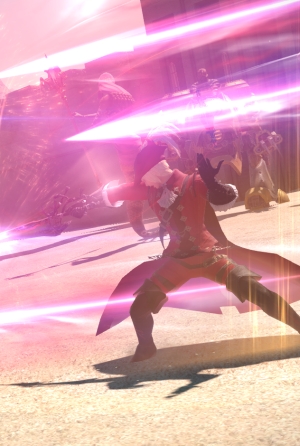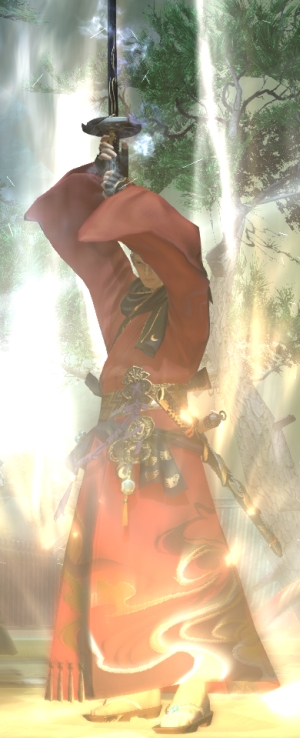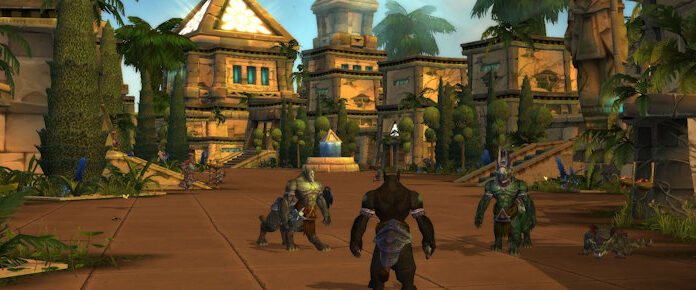
Beyond that, I was curious about how they were going to manage the mechanics in general. Red Mage needed to feel like a hybrid melee and caster damage dealer that didn’t exactly mirror anything in the game but still felt related to Black Mage and White Mage both, and Samurai needed to carve a distinct space for itself in the niche of melee damage. So there were question marks.
I’m happy to say that I walked away from both eager to play more, however. Both of the new jobs feel like responsive damage dealers with very different tricks, feeling no more powerful than existing jobs but definitely feeling very unique. They fill niches which heretofore had not been filled, and while they may not be exactly what you’re looking for, they deliver on the promise of their names.

Red Mage
First things first, and it’s something I am sad to report on: Red Mage’s status as a melee character is entirely a charade. It’s shadowplay, something made to look right with abilities and animations. If you were hoping to spend most of the fight cuddled up to the target in melee range, you will be mildly disappointed; you certainly can, but it’s the equivalent of a Summoner walking into melee range to book-smack the target. It’s not productive.
That’s all right, however, because the actual play of the job is fun. It’s all about building balance, timing your buffs, and unloading in a flurry of steel and spellcasting.
Red Mage is outfitted with an impressive array of spells as well as a three-hit weaponskill combo, a melee charge, and a melee backstep. That four-hit combo also naturally segues into the Verholy and Verflare spells at the highest level, which are further tied into the balance mechanic. It’s all about maintaining your balance, or more accurately, building up your balance. Once you pass a certain point, your weaponskills become empowered and deal significantly more damage; they will, however, also drain your balance gauge in the process.
At its core, then, Red Mage wants to build up the balance gauge, swing into melee, and then spring back out. There are five spells which form the core of this rotation. Jolt is your basic attack spell, filling both your black and white gauges a small amount and dealing small but appreciable damage. You also have a basic black magic and white magic attack spell, each of which fills its respective gauge far more substantially and has a chance of buffing you to cast another, more powerful black or white magic spell.
The trick, however, is that those basic black and white spells have painful casting times. Which means that your rotation becomes a game of juggling your casts so that you’re casting these spells through your Chainspell buff. Chainspell goes on every time you finish casting a spell and makes your next spell an instant cast; it only triggers when you do actually finish casting a spell normally, however. (Cheating it out with Swiftcast, for example, will not trigger Chainspell.)
 You can probably start to see the rotation, but let me make it a bit more explicit. I open a fight with Jolt, and that triggers Chainspell. I then consume that buff to cast Veraero, which gives me the proc to cast Verstone, the third hit. Verstone has a normal casting time, so I can cast that right away, but now my White gauge is getting overbalanced. So I’d better switch over to the black magic spell to start getting my gauge back in balance…
You can probably start to see the rotation, but let me make it a bit more explicit. I open a fight with Jolt, and that triggers Chainspell. I then consume that buff to cast Veraero, which gives me the proc to cast Verstone, the third hit. Verstone has a normal casting time, so I can cast that right away, but now my White gauge is getting overbalanced. So I’d better switch over to the black magic spell to start getting my gauge back in balance…
Getting too far out of balance will have a detrimental effect on your rotation. However, Verholy and Verflare, as mentioned about, cap off your attack chain, and both of them benefit from you being slightly off-balance. Thus, you want to aim at a slight imbalance with your spells, then go into a rush and spend, then flip back, fire off the right spell, and swap over for the next rotation to start the sequence up again.
There’s slightly more to the rotation, of course, as you also have a melee-range weaponskill and an AoE spell with similar functionality to your single-target rotation, but you get the basic idea. It’s about filling and spending while keeping a close watch on your overall balance.
Red Mages also have a spot of party utility with a heal and a raise, both of which can be used along with Chainspell if you’re paying attention. I got quite a bit of power out of being able to chain-heal two people in quick succession during periods when I couldn’t be doing much DPS or when our healer was out of commission for whatever reason. It’s not why you’re there, obviously, but you can make good use of it, arguably even more so than a Summoner can.
At the end of the day, I’m impressed by Red Mage. The job manages to feel like it’s integrating all of the diverse and somewhat bizarre aspects of the job across its many incarnations, and you wind up with a job that does something distinct from its contemporaries. It feels like it really does wrap all of the messy parts of that job identity up into one package, and that’s no small feat.

Samurai
It’s kind of ironic that Samurai and Red Mage are the two new jobs for the expansion, because they’re both iconic but have different problems in adapting for FFXIV. Red Mage has the problem of having an identity which is hard to slot into a role, since the identity is traditionally “do a bit of everything.” Samurai, on the other hand, is an iconic job that has never actually held on to any specific mechanics; every single incarnation has little in common with its predecessors aside from “has a katana.”
So, good news, Samurai fans! You have a katana. That sure is a katana. There, are we done?
No, we’re not done. Joking aside, there are certain ideas which have managed to be retained over time. Samurai have a degree of mental discipline, and they excel at mastering precision strikes. Unlike Ninja, they don’t veer over into magical territory; instead, their more-than-human tricks are a result of focused effort and action in precisely the right way. In Final Fantasy XI, which is their obvious inspiration, they were perhaps best known for Meditate, which allowed them to chain together a large number of weaponskills and made them intensely powerful as a subjob.
 Samurai in FFXIV retain Meditate, and it’s a good thing they do, because it’s clearly a part of their core identity. They also inherit some of the nested weaponskill lines that other jobs have moved away from. Samurai isn’t about long combos or shifting forms; instead, it’s about stacking the right combos together before unleashing a perfect strike.
Samurai in FFXIV retain Meditate, and it’s a good thing they do, because it’s clearly a part of their core identity. They also inherit some of the nested weaponskill lines that other jobs have moved away from. Samurai isn’t about long combos or shifting forms; instead, it’s about stacking the right combos together before unleashing a perfect strike.
It’s impossible to overstate how Samurai combos are different from others. Ninja players are familiar with how all of a Ninja’s combos flow off of a single opening strike right now, and Samurai takes that to the next level. Both the AoE and single-target skills have combos, and each of those combos ends in a skill which unlocks one of the three Samurai symbols. You can then use Iaijutsu to deploy a special attack based on how many of these symbols have been unlocked first.
One symbol hits the target with a solid DoT effect. Two symbols deploys an AoE strike. Three symbols is a powerful single-target hit. And from that alone, you can probably guess what the flow looks like. Use a short combo, hit the DoT, use all three combo chains, hit the more powerful strike. Refresh and restart.
What breaks the cycle and prevents it from being a rote set of motions are the various uses of the Samurai’s slow-building Kenki power. Kenki can be used for many things – quick charges, melee strikes, self-buffs, and so forth. Thus, you’re not just cycling through your combos, but managing your power and holding it in reserve for potentially needed tools. You also have the aforementioned Meditate, which allows you to execute combo enders without going through the full combo, an obvious tool for building up to Iaijutsu in a hurry.
Equally nifty is the ways you can plan ahead as a Samurai. You’re in an AoE phase, for example, but you know that won’t last long; you thus should plan your combos so that you can cycle through two multi-target combos, then activate your last symbol with your single-target combo and use a powerful strike. Of course, you could also Meditate to deploy that last symbol, or you could use your AoE Iaijutsu and then Meditate…
It’s a bit harder to articulate the different between Samurai and the other melee jobs than it is to articulate how Red Mage is different, but it really does feel like a distinct job. It doesn’t have the constant rush of Monk, the long building combos of Dragoon, or the weaving of steel and timing that Ninja offers; instead, it’s much more about managing resources and preparing in advance. Combined with excellent visuals and the sheer visual flavor, and I’m fond of it.
Perhaps not quite as fond of it as I am of Red Mage, but you can’t have everything.
 Final Fantasy XIV Stormblood preview: Everything you need to know about the expansion
Final Fantasy XIV Stormblood preview: Everything you need to know about the expansion
 Final Fantasy XIV Stormblood preview: Samurai and Red Mage impressions
Final Fantasy XIV Stormblood preview: Samurai and Red Mage impressions
 Final Fantasy XIV Stormblood preview: Tank jobs
Final Fantasy XIV Stormblood preview: Tank jobs
 Final Fantasy XIV Stormblood preview: Melee DPS jobs
Final Fantasy XIV Stormblood preview: Melee DPS jobs
 Final Fantasy XIV Stormblood preview: Caster DPS jobs
Final Fantasy XIV Stormblood preview: Caster DPS jobs
 Final Fantasy XIV Stormblood preview: Ranged DPS jobs
Final Fantasy XIV Stormblood preview: Ranged DPS jobs
 Final Fantasy XIV Stormblood preview: The healers
Final Fantasy XIV Stormblood preview: The healers
 Final Fantasy XIV Stormblood preview: The dungeon
Final Fantasy XIV Stormblood preview: The dungeon
 Final Fantasy XIV Stormblood preview: Our interview with Naoki Yoshida
Final Fantasy XIV Stormblood preview: Our interview with Naoki Yoshida














